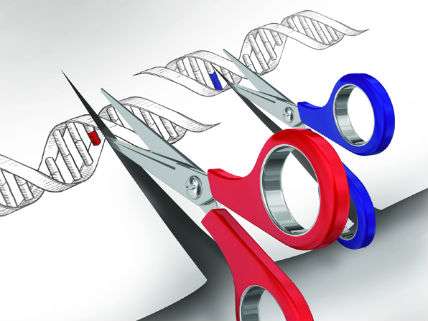CRISPR Gene-Editing Is Scientific "Breakthrough of the Year"
"If scientists can dream of a genetic manipulation, CRISPR can now make it happen"

Every December, Science lists the most significant scientific discoveries and advances of the previous year and declares one as the Breakthrough of Year. This year's winner is the fantastic gene-editing technology CRISPR. As I reported earlier:
Derived from what amounts to a bacterial immune system for fighting off attacking viruses, the CRISPR gene-editing technique was first developed barely three years ago. CRISPR can edit genes much like a word processing program can edit text. Researchers hope it will allow them to cure cancer, correct genetic diseases, generate more productive and nutritious crops and farm animals, spread desired genetic modifications through wild ecosystems, engineer pigs as organ donors for people, and prevent heritable diseases by altering the genomes of human embryos—all in the not-so-distant future.
Science's Breakthrough article notes among other things that researchers have created…
…a gene drive that, unleashed in a lab population of mosquitoes, spread genes that prevent the insects from harboring malaria parasites. Weeks later, working with another malaria-carrying mosquito, Burt and colleagues reported the same thing with genes that rendered the females infertile and could quickly wipe out a population. Debates are now erupting over the benefits and ecological risks of releasing such insects into the wild—and whether gene drives could also thwart invasive species such as Asian carp and cane toads, or combat other animal-borne pathogens such as the one causing Lyme disease.
In other labs, researchers harnessed the technique to create a growing menagerie of genetically engineered animals and plants: extramuscular beagles, pigs resistant to several viruses, and wheat that can fend off a widespread fungus. Longer-lasting tomatoes, allergen-free peanuts, and biofuel-friendly poplars are all on the drawing board. Depending on how it's wielded, CRISPR can do its work without leaving any foreign DNA behind, unlike earlier techniques for genetically modifying organisms, which poses a challenge for regulations based on the presence of foreign DNA. …
The biomedical applications of CRISPR are just starting to emerge. Clinical researchers are already applying it to create tissue-based treatments for cancer and other diseases. CRISPR may also revive the moribund concept of transplanting animal organs into people. Many people feared that retroviruses lurking in animal genomes could harm transplant recipients, but this year a team eliminated, in one fell swoop, 62 copies of a retrovirus's DNA littering the pig genome. And the international summit saw many discussions of CRISPR's promise for repairing genetic defects in human embryos, if society dares to cross what many regard as an ethical threshold and alter the human germline.
In short, it's only slightly hyperbolic to say that if scientists can dream of a genetic manipulation, CRISPR can now make it happen. At one point during the human gene-editing summit, Charpentier described its capabilities as "mind-blowing." It's the simple truth. For better or worse, we all now live in CRISPR's world.
Better, I think.
The whole Science Breakthrough of the Year article is worth your attention. For more background see my article on the human gene-editing biotech summit earlier this month that will likely turn out to be far more historically consequential than the Paris climate change conference.

Show Comments (64)